Herschel reveals how most stars formed in the Universe
13 September 2011
Do galaxies form their stars through violent and tumultuous merging events or rather via more steady and gentle processes? Scrutinising thousands of galaxies across the past 11 billion years of cosmic history with ESA's Herschel Space Observatory, astronomers have, for the first time, been able to answer this long-standing question. Contrary to previous belief, the new data reveal that most of the stars ever formed in the history of the Universe have done so quietly.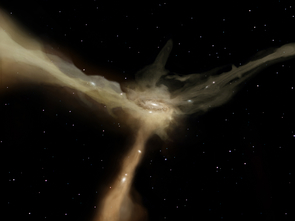 |
| Artist's impression of a galaxy forming stars in a gentle and steady fashion. Credit: ESA/AOES Medialab |
Today galaxies form stars at a rather leisurely pace, or at least this is what astronomers infer from observing galaxies in the present-day Universe. On average, the Milky Way produces only a handful of new Sun-like stars every year. Occasional dynamical interactions between massive galaxies, or mergers, may trigger intense bursts of star formation and cause their stellar mass to increase much more swiftly. However, such episodes are known to be extremely rare in the current cosmic epoch.
But what about the past? Did galaxies experience similar fiery phases of enhanced star formation more often, or have they always been producing stars at a steady and gentle rate? By observing increasingly distant galaxies, astronomers are able to peer deeply into the Universe's past history and gather new clues to tackle such questions. ESA's Herschel Space Observatory is a unique tool for such studies, as its spectral coverage fits perfectly the range of infrared wavelengths where star-forming galaxies emit the bulk of their radiation.
Prior to Herschel, observations seemed to show that merger-triggered starbursts might have been the dominant mechanism responsible for star formation at earlier times. This was also motivated by the fact that merging events were indeed more common in the early history of the Universe than at more recent epochs. New data collected with Herschel urge astronomers to reconsider the role of mergers in the context of star formation.
"We have established that mergers' contribution to the build-up of stars in the Universe has been minor at virtually all cosmic times, and that the vast majority of galaxies have been producing stars via less frenzied processes," explains David Elbaz from CEA Saclay, Service d'Astrophysique, France, who led a study investigating the rate of star formation in over 2000 galaxies. The study is based on the deepest Herschel images of the GOODS fields, achieved by pushing the observatory to its instrumental limits. The angular resolution provided by Herschel's large telescope allowed the compilation of a more comprehensive galaxy census than those available in the past, which were dominated by the presence of bright, star-bursting galaxies and led to incorrect extrapolations.
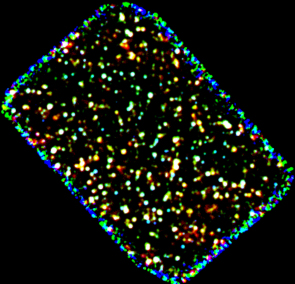 |
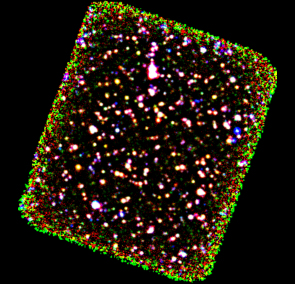 |
| Composite, three-colour view of the GOODS-North (left) and GOODS-South (right) fields as observed by Herschel. Credit: ESA/NASA/JPL-Caltech/GOODS-Herschel consortium/David Elbaz | |
"The galaxies we examined are spread over the past 11 billion years of the Universe, corresponding to 80 percent of its present age. Surprisingly, their infrared emission exhibits remarkably similar properties over a very extended time span," comments Elbaz.
The study investigates the relation between the total infrared output of the galaxies, which quantifies their star formation activity, and a measure of their infrared emission at wavelengths around 8 micron. The latter is due to polycyclic aromatic hydrocarbon (PAH) molecules, carbon-rich dust grains that populate the interstellar medium, and is a good indicator of the spatial extent of a galaxy's star-forming regions. It is in fact at these wavelengths that the two main modes of star formation leave their distinctive signature.
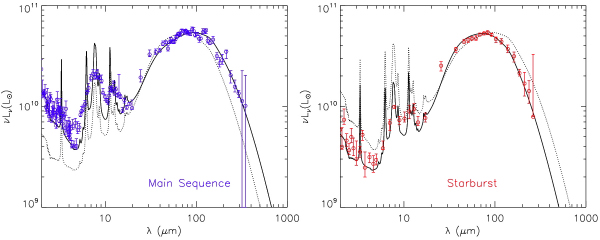 |
| The typical Spectral Energy Distribution of Main-Sequence (left) and Starburst (right) galaxies at infrared wavelengths. Image courtesy of David Elbaz. |
When triggered by a galactic merger, fierce star formation takes place in very compact regions of a galaxy, and releases an intense flux of ionising ultraviolet radiation. This, in turn, has a destructive effect on PAH molecules and translates into weak emission at 8 micron. In contrast, when galaxies produce stars via steadier processes, star formation is diluted across the entire galaxy, resulting in less intense ionising flux. Such an environment preserves larger amounts of PAH molecules, giving rise to a stronger 8-micron emission.
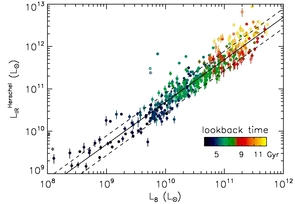 |
| The 'infrared main sequence' for star-forming galaxies. Image courtesy of David Elbaz. |
The study shows that most galaxies (about 80 per cent) display a tight correlation between these two infrared indicators, independent of their distance to us or their total brightness, thus suggesting the existence of an 'infrared main sequence' for star-forming galaxies. Starbursts are outliers with respect to this relation, and sum up to only about 20 per cent of the sources at all probed epochs. "This highlights how star formation ignited by merging events is only a marginal process in the Universe. Even galaxies that form stars very efficiently are mostly just a scaled-up version of 'normal' galaxies like our Milky Way," explains Elbaz.
These results are corroborated by a complementary study, led by Giulia Rodighiero from the University of Padova, Italy. Rather than scrutinising galaxies over an extended timescale, Rodighiero and her collaborators focussed on a particular cosmic epoch, namely between 9 and 11 billion years ago. "At this epoch, star formation in the Universe was at its peak, and we wanted to assess the role of starbursts during this crucial period in cosmic history," she explains.
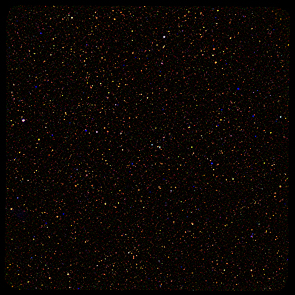 |
| Composite, three-colour view of the COSMOS field as observed by Herschel. Credit: ESA/NASA/JPL-Caltech/PEP Key Programme consortium/Dieter Lutz |
In order to compile a large sample of such distant galaxies, the team combined Herschel observations of the GOODS-South field and of the much wider COSMOS field. "This rich dataset allowed us to quantify the influence of star-bursting galaxies during early cosmic star formation, which turns out to be only minor," Rodighiero notes. Hence, both studies conclude that merging events, albeit important for shaping the morphology of certain types of galaxies, are by no means the dominant process that powers star formation.
Whereas they now know that most stars in the Universe came to life in a gentle and steady fashion, astronomers are still in the dark as regards the underlying physical processes. "One possible scenario, recently proposed in the literature, is based on computer simulations and suggests that rapid, narrow streams of cold gas might feed galaxies, providing them with a continuous flows of raw material to support their star-forming activity," notes Elbaz. In fact, massive galaxies are known to form in the knots of the 'cosmic web', a complex network of sheets and filaments, consisting of (mostly) dark matter and gas, that pervade the entire Universe. However, the actual process of stream accretion onto a galaxy has never been directly observed to date and this scenario remains only speculative.
"Herschel was conceived with the investigation of the cosmic history of star formation very much in mind," comments Göran Pilbratt, Herschel Project Scientist at ESA. "The debate on the role of mergers in star formation has been going on for years, and these stunning observations now provide very interesting and unexpected results," he concludes.
Notes for editors
The results presented in this article are based on two studies, one led by D. Elbaz and based on Herschel observations of the GOODS North and South fields, performed using the PACS and SPIRE instruments within the GOODS-Herschel Open Time Key Programme, and the other led by G. Rodighiero and based on observations of the COSMOS and GOODS-South fields, performed using the PACS instrument as a part of the PACS Evolutionary Probe (PEP) Guaranteed Time Key Programme.
The GOODS (Great Observatories Origins Deep Survey) fields are two carefully selected patches of the northern and southern sky, centred on the Hubble Deep Field North and the Chandra Deep Field South, respectively. Each field measures 10 by 16 arcminutes. As they do not contain any bright star and are not contaminated by strong emission coming from the Milky Way, they are ideal for studying galaxy evolution out to very high redshifts. The GOODS fields have been the target of deep surveys conducted during the past decade over an extremely broad wavelength range, with ESA's and NASA's space observatories and the foremost ground-based telescopes.
The COSMOS (Cosmic Evolution Survey) field is a 2 square degree equatorial field which was carefully chosen by a team of American, European and Japanese astronomers. The project was implemented as a NASA/ESA Hubble Space Telescope Treasury Program and it was the largest ever survey to be performed with this telescope. The width of the field allows astronomers to study the formation and evolution of galaxies in the broader cosmological context of the large-scale structure of dark matter in which galaxies are embedded. The COSMOS field has also been surveyed from other observatories around the world, including the VLA radio telescope, ESO's VLT in Chile, ESA's XMM X-ray satellite, and Japan's 8-meter Subaru telescope in Hawaii.
Herschel is an ESA space observatory with science instruments provided by European-led Principal Investigator consortia and with important participation from NASA.
The PACS instrument contains an imaging photometer (camera) and an imaging spectrometer. The camera operates in three bands centred on 70, 100, and 160 μm, respectively. PACS has been developed by a consortium of institutes led by MPE (Germany) and including UVIE (Austria); KU Leuven, CSL, IMEC (Belgium); CEA, LAM (France); MPIA (Germany); INAF-IFSI/OAA/OAP/OAT, LENS, SISSA (Italy); IAC (Spain). This development has been supported by the funding agencies BMVIT (Austria), ESA-PRODEX (Belgium), CEA/CNES (France), DLR (Germany), ASI/INAF (Italy), and CICYT/MCYT (Spain).
The SPIRE instrument contains an imaging photometer (camera) and an imaging spectrometer. The camera operates in three wavelength bands centred on 250, 350 and 500 μm, and so can make images of the sky simultaneously in three sub-millimetre colours. SPIRE has been developed by a consortium of institutes led by Cardiff Univ. (UK) and including Univ. Lethbridge (Canada); NAOC (China); CEA, LAM (France); IFSI, Univ. Padua (Italy); IAC (Spain); Stockholm Observatory (Sweden); Imperial College London, RAL, UCL-MSSL, UKATC, Univ. Sussex (UK); Caltech, JPL, NHSC, Univ. Colorado (USA). This development has been supported by national funding agencies: CSA (Canada); NAOC (China); CEA, CNES, CNRS (France); ASI (Italy); MCINN (Spain); SNSB (Sweden); STFC (UK); and NASA (USA).
Related publications
D. Elbaz, et al., "GOODS-Herschel: an infrared main sequence for star-forming galaxies", 2011, Astronomy & Astrophysics, vol. 533, A119. DOI: 10.1051/0004-6361/201117239
G. Rodighiero, et al., "The lesser role of starbursts for star formation at z=2", 2011, The Astrophysical Journal Letters, vol. 739, issue 2, L40. DOI: 10.1088/2041-8205/739/2/L40
Contacts
David Elbaz
CEA Saclay, Service d'Astrophysique
Gif-sur-Yvette Cedex, France
Email: delbaz cea.fr
cea.fr
Phone: +33-1 69 08 54 39
Giulia Rodighiero
Dipartimento di Astronomia
Università di Padova
Italy
Email: giulia.rodighiero unipd.it
unipd.it
Phone: +39 329 8963748
Göran Pilbratt
Herschel Project Scientist
Research and Scientific Support Department
Science and Robotic Exploration Directorate
ESA, The Netherlands
Email: gpilbratt rssd.esa.int
rssd.esa.int
Phone: +31 71 565 3621






